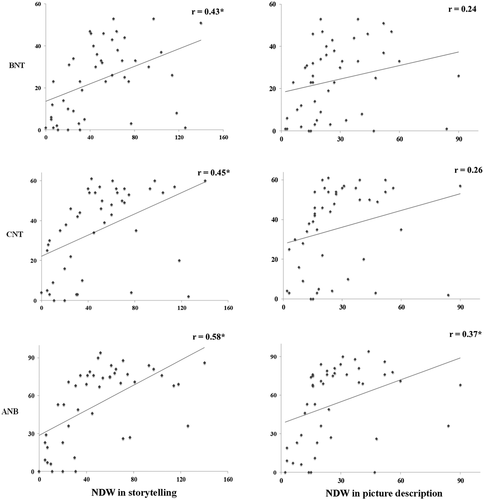Figures & data
Table 1. Participant’s demographic information.
Table 2. Descriptive statistics of the measures extracted from the discourse samples produced by the neuro-typical and aphasia groups.
Figure 1. Correlations between word retrieval during picture naming and discourse production in post-stroke aphasia. Scatterplots illustrating the correlations between picture naming accuracy (y-axis) and word retrieval during two discourse tasks measured using NDW (x-axis). Significant correlations (p < 0.01) are indicated with an asterisk. BNT = Boston Naming Test (Kaplan et al., Citation1983), CNT = 64-item Cambridge Naming Test (Bozeat et al., Citation2000), ANB = action pictures from the Object and Action Naming Battery (Druks & Masterson, Citation2000).

Figure 2. Correlations of word retrieval and content word fluency between different discourse tasks in post-stroke aphasia. Scatterplots illustrating the correlations of word retrieval measured using NDW (left), and content word fluency measured using CIU (right) between simple picture description (y-axis) and naturalistic storytelling narrative (x-axis). Asterisks indicate significant correlations (p < 0.001).

Figure 3. Correlations of content word fluency between scores on the new transcription-less index and CIU produced during discourse in post-stroke aphasia. Scatterplots illustrating the correlations between scores on the new transcription-less index (y-axis) and content word fluency measured using the formal transcription and quantitative scoring approach (x-axis) during storytelling narrative (left) and picture description (right). Asterisks indicate significant correlations (p < 0.001).

